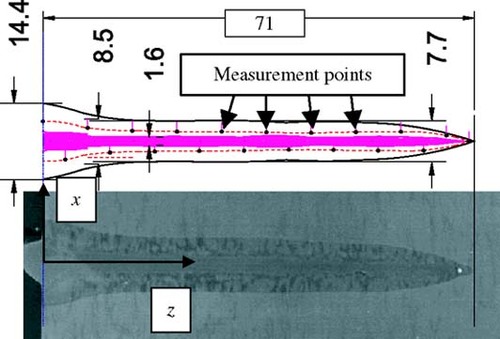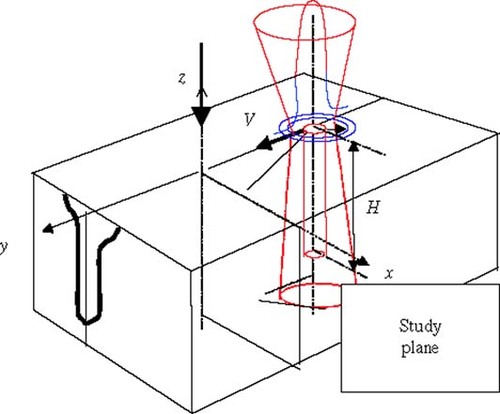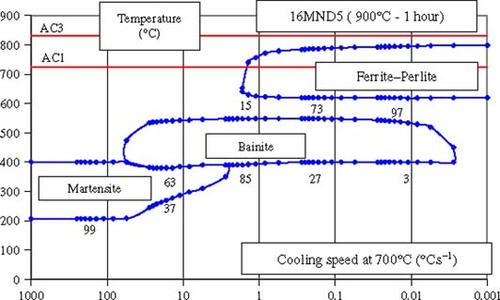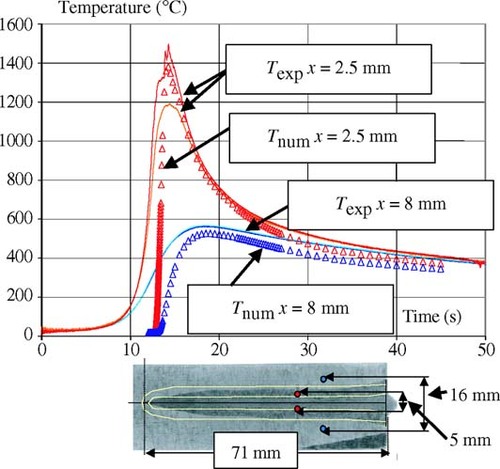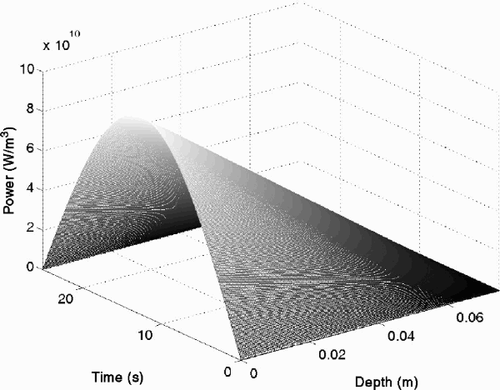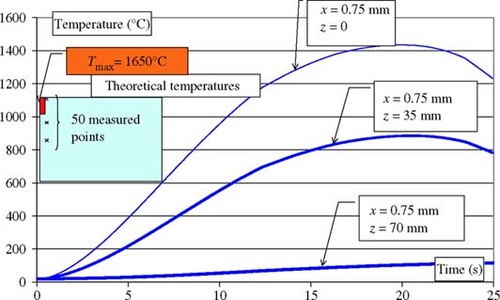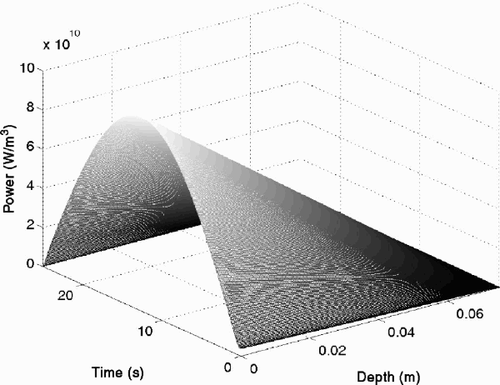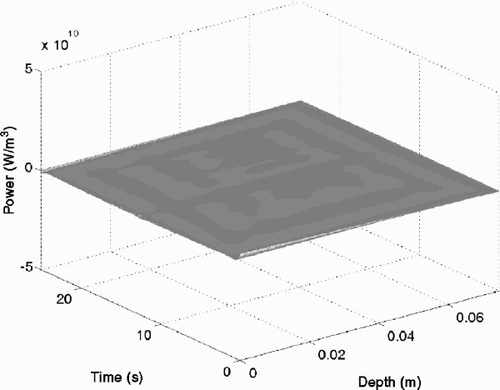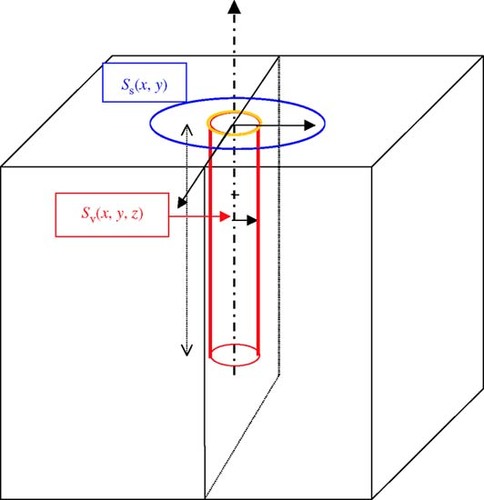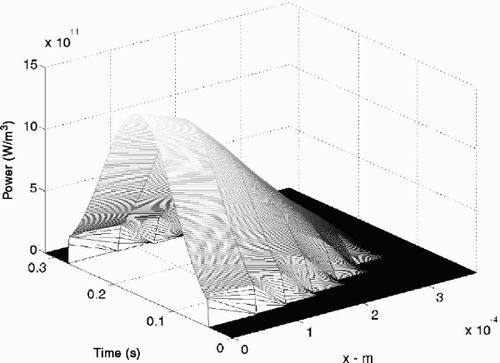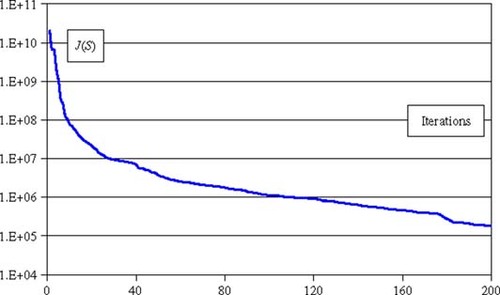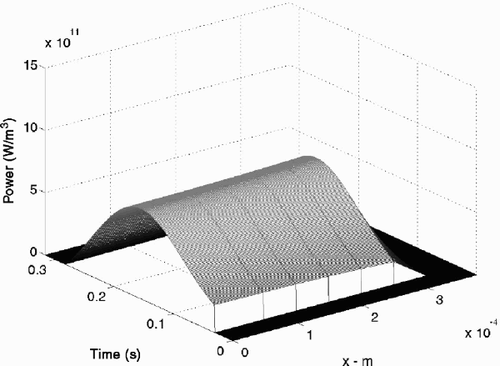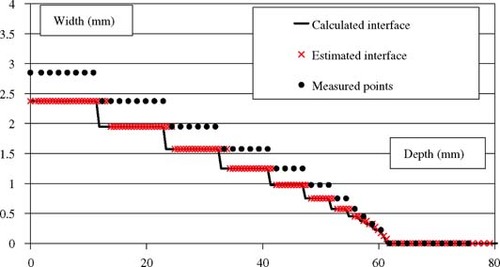Abstract
This article is concerned with the estimation of a heat source applied in the electron beam welding process by using the micrographic information (hardness, optical micrograph, etc.) and temperature measurements in solid phase. The aim is to identify the energy distribution that is applied in the liquid and vapor zones. This identification is realized at each time in a transversal plane perpendicular to the welding axis. For this work, the goal is to analyze the feasibility of the estimation. So we do not use noise with the theoretical measurements. At last, the iterative regularization method will be used for this two-dimensional metallurgical inverse heat transfer problem.
1. Introduction
Welding is an assembling operation that affects both mechanical and structural properties and which is very sensitive to control parameters of technological processes. The first stage of this study is to choose these parameters which lead to an acceptable welding quality. The main difficulty of the theoretical analysis is that the exact distribution of the thermal energy absorbed and generated in the liquid and vapor zones is not easy to predict and cannot be measured directly. When studying the welding, the theoretical analysis use complementary experimental information: the temperature measurements near the liquid zone and the microstructural properties (hardness, optical micrograph, etc.).
The objective of this work is the estimation of the energy distribution in the welding zone. The temperature difference between the welding and solid zones is big enough, but there is a strong damping effect in the solid zone. That is why it is difficult to estimate correctly the energy distribution from the temperature measurements taken at points that are too far from the welding zone.
Many works deal with the estimation of boundary conditions or the determination of distributed heat flux on the boundary of the body Citation[1–Citation3]. Few of these works consider experimental situations involving unknown heat sources. Silva Neto and Ozisik Citation[4] used the conjugate gradient algorithm to estimate the time-varying strength of a line source placed in a rectangular region with insulated boundaries, but the location of the source was specified. Le Niliot Citation[5] studied linear inverse problems with two point heat sources, and experimental results were presented in Citation[6].
In many studies, the inverse fusion and solidification problem have been analyzed which use a simplified approach based on only a conduction model in the liquid and vapor zones. Under these assumptions, 1D or 2D Stefan problems taking into account only the conduction effects in all the phases during the process were considered. The objective was to estimate an energy distribution Citation[3], or a motion of the solid–liquid interface Citation[7–Citation10]. Another approach was to take into account the convection effects described by the Navier–Stokes equations in the liquid and vapor zones Citation[11]. At last, mixed approaches were employed, in which an apparent source term is determined in the liquid and vapor zones representing the different phenomena Citation[12].
In this article, we use the first hypothesis for the electron beam (EEB) welding process. We consider only the conduction effects for all phases (solid, liquid and vapor). The iterative regularization method Citation[2] is used to estimate the dissipation energy in the liquid and vapor zones. First, we present the EB welding technique and the used steel sample. Second, we describe the direct problem including the simulation of phase transformations and the source term (EB). Third, the estimation procedure is described. Finally, the estimation results are discussed.
2. The electron beam welding
2.1. Principle
The EB welding is an assembling process in vacuum using a high density energy beam. This technique permits the welding of the high thicknesses (up to 16 cm) with a low width and a narrow Heat Affected Zone (HAZ). At the beginning of the welding process, the high power density of the electron beam leads to an evaporation of the material and then to a keyhole (). It is this keyhole and its displacement that generate the welded joint. The high penetration capacity of the beam with a narrow fusion zone characterizes the EB welding in comparison with other weld methods. For these other methods, the penetration is limited by the heat conduction Citation[13].
For this study, weld joints are used which are realised in the “Direction des Constructions Navales” (DCN) in Indret (44-France) (power of this electron beam: 100 kW). The welds are made of 18MnNiMo 5 steel samples (ASTM A508 Cl.3) or with aluminum samples. In this article, a partial penetration welded joint is analyzed. shows the micrography of this sample which is used to determine precisely the locations of the measurement points by using a scan of this welding joint. The welding parameters are: voltage U = 60 kV, current I = 0.29 A, velocity v = 2.5 mm s−1, focus current If = 2.46 A. The work of Carin et al. Citation[14] presents the experimental parts of this study.
The high temperature level in the fusion and vapor zones prevents the installation of the thermocouples in these zones. The used thermocouples (d = 80 µm; K type, C type or S type) are thus located in the HAZ (750°C<T<1450°C). and show the positions of measurement points.
With the experimental temperatures obtained from the thermocouples and corresponding diagrams (CCT or TTT) we will validate the simulation of the metallurgical transformations by comparing the experimental and simulated thermal and metallurgical parameters. Furthermore, temperatures computed at the thermocouple locations by solving the direct problem will be used to estimate the source term in the fusion and vapor zones.
Table 1. Thermocouple locations.
2.2. Numerical simulation of the electron beam welding
Several works are concerned with the numerical simulation of the EB welding in the laboratory LET2E Citation[15]. In these works, the SYSWELD code Citation[16] was used. In this study, we use a new code analogous to SYSWELD which is incorporated in the developed estimation code. The finite difference method based on an implicit scheme is used to solve the direct and inverse problems. The equations are the heat conduction Equationequation (1)(1) and the metallurgical kinetic Equationequations (2)
(2) of the type Leblond and Devaux Citation[17], and Koistinen and Marburger Citation[18]. The studied domain is one-half of the transversal plane taken perpendicular to the welding axis (),
(1)
(phase no. 1 = ferrite–perlite, phase no. 2 = bainite, phase no. 3 = martensite and phase no. 4 = austenite)
(2)
The boundary and initial conditions are the following: at the lower, upper and lateral surfaces, only the radiative conditions are fixed because the welding process is carried out in vacuum. For example at the lower surface, the boundary condition is:
(3)
On the axis:
(4)
Initial conditions:
(5)
In the heat conduction Equationequation (1)
(1) , the source terms (∂ Pα /∂ t)Lα γ (T) and ∂ (ρ H)/∂ t allow to take into account the phase change enthalpy according to the temperature of the sample (metallurgical transformations for the first term, fusion and evaporation for the second). The transformation energy is calculated according to the phase enthalpy: Lα γ (T) = ργ Hγ − ρα Hα and by considering two metallurgical phases only: γ (austenite) and α (ferrite, perlite, bainite or martensite). The enthalpies of the phases α and γ are computed with the use of polynomial functions between 100 and 1450°C. The parameters of the metallurgical kinetic equations are calculated by simulating the CCT diagram (example: ).
For each time and space node, the cooling speed and the temperature value are used. With this information, the percentage Pi of the metallurgical transformation is computed. Moreover, the thermophysical characteristics ρ(T ), C(T ) and λ(T ) are calculated at all time steps by a law of mixtures according to the temperature (example: λ(T) = Pγ × λγ (T ) + Pα × λα (T) = Σi Pi λ (T)).
For the phase γ and for T<1450°C:
(6)
For the phase α and for T<750°C:
(7)
The other thermal transformations are computed between 1450 and 1550°C for the fusion and between 2600 and 2800°C for the evaporation. These enthalpies are given in Costantini's work Citation[13]: ΔHfus = 391970 J kg−1 and ΔHvap = 6332879 J kg−1. At last, the thermophysical characteristics of the liquid and vapor phases are computed at 1450°C.
The initial data of the model are:
| a. | The mesh; | ||||
| b. | The thermophysical characteristics ρ(T ), C(T ), λ(T ), and Lαγ for the different phases according to the temperature; | ||||
| c. | The initial and final temperatures of thermal transformations for all phases (CCT diagram); | ||||
| d. | The initial temperature T0 = 20°C in whole domain; | ||||
| e. | The ambient temperature Tinf; | ||||
| f. | The emissivity of the considered material is supposed to be constant and equal to 0.8. | ||||
shows the comparison between the experimental data and numerical results for a Gaussian source Citation[14]. Globally, we find a good level for the maximal temperatures. Some problems stay because, in this 2D transverse model, we do not have the diffusion effect forward the beam. For this reason, it seems to be important to estimate an apparent source term for modeling the diffusion effect in the steel.
3. Estimation algorithm
The objective of this research is to determine a source term S(x, z, t). The determination is conducted from the temperature values measured in the HAZ at a distance between 3 and 10 mm from the welding axis. The time step used in the estimation is Δt = 0.001 s and the discretization on the welding axis is Δz = 0.5 mm and Δx = 0.5 mm.
3.1. Minimization procedure
The use of the iterative regularization method leads to the variational formulation of the inverse problem of estimating the source term and the residual functional minimization by utilizing the unconstrained conjugate gradient method. The residual functional is defined as:
(8)
where T(xj, zj, t; S) and Yj (t) are the computed and measured temperature histories respectively at N various measurement points of the material. The inverse algorithm consists in minimizing this residual functional under constraints on the temperature given by the direct problem (Equationequations (1)
(1) to Equation(7)
(7) ).
The function S(z, x, t) is considered as an element of the Hilbert space L2. The source term is computed as a grid function. In the iterative method, the desired function approximations are built at each iteration as follows:
(9)
where n is the iteration index, n* is the index of the last iteration, γ n is the descent parameter, Dn is the descent direction given by:
(10)
where:
(11)
⟨,⟩ is the scalar product in Hilbert space L2, S 0 is an initial approximation of the function to be estimated given a priori.
In the absence of noise, the iteration procedure is carried on until the following stopping criterion is verified:
(12)
The residual functional gradient ∇ Jn is calculated at each computational grid node (x, z, t) by the following analytical relationship:
(13)
where Ψ(x, z, t) is the solution of the following adjoint problem derived by using the approach given in Citation[2]:
(14)
(15)
(16)
(17)
(18)
(19)
The descent parameter of γ n is computed as follows:
(20)
where θ(x, z, t) is the solution of the following direct problem in variations:
(21)
(22)
(23)
(24)
(25)
(26)
where δS(x, z, t) = Dn(x, z, t).
The variation problem is obtained with a variation δS of the source term S(x, z, t). In that case, the temperature T(x, z, t) is perturbed by a variation θ(x, z, t). Writing Equationequations (1)(1) to Equation(5)
(5) for the perturbed solution and subtracting the same equations for the solution T, we obtain the variation problem. For example:
(27)
3.2. Regularization
The inverse problems are ill-posed and numerical solutions depend on the fluctuations occurring at the measurements. Small fluctuations at the measurements can generate big errors in the inverse problem solution. So regularization is needed to stabilize the solution. According to the iterative regularization method, the regularizing discrepancy criterion is used for the stabilization:
(28)
where
(29)
σ2(xj, zj, t) is the standard deviation of the temperature measurement errors. The index n* is the index of the last iteration. For this index, the Equationequation (28)
(28) is validated and n* is defined as the regularization parameter in the method.
3.3. Computational scheme
The three systems (direct, adjoint and variation problems) are solved numerically using a finite difference method and an implicit scheme. The estimation procedure consists of the following steps:
| 1. | Define the initial values of S 0(x, z, t) | ||||
| 2. | Solve the direct system: Equationequations (1) | ||||
| 3. | Calculate the residual functional criterion J(S): Equationequation (8) | ||||
| 4. | Verify the stopping criterion: Equationequation (12) | ||||
| 5. | Solve the adjoint problem: Equationequations (14) | ||||
| 6. | Calculate the residual functional gradient: Equationequation (13) | ||||
| 7. | Calculate the descent direction: Equationequations (10) | ||||
| 8. | Solve the direct problem in variations: Equationequations (21) | ||||
| 9. | Calculate the descent parameter γn: Equationequation (20) | ||||
| 10. | Improve the desired function S n+1(x, z, t): Equationequation (9) | ||||
| 11. | Go to step (2) | ||||
| 12. | Stop | ||||
4. Numerical simulation
To verify the numerical algorithm, two test cases with fixed exact forms of the source term given a priori are analyzed.
The first form is defined by:
(30)
The source term is a source imposed in x = 0 which varies linearly with z (). This source gives a small fused zone (Δx = 0.75 mm; Δz = 1.5 cm) and the maximum temperature at the point x = 0, z = 0 is equal to 1650°C. The heat distribution crosses the analyzed transversal plane in 25 s. The computational time step is equal to 0.05 s. For the estimation, we use only the exact measurements computed in the HAZ in 25 s (). In fact, we have chosen these parameters for the verification of the computational algorithm. One parameter that characterizes the difficulty of the inverse problem solution is the number ΔF0 = aΔt/Δx2. This number is calculated with average values: a = 5 × 10−6 m2 s−1 (thermal diffusivity), Δx = 0.75 mm (minimum distance between the measurement points and the axis), Δt = 0.05 s (time step) and we obtain ΔF0 = 0.44. Generally, we have no problem for the source estimation when the Fourier number is greater than 0.1.
shows the temperature histories for three measured points taken on a vertical line near the fused zone. The difference between the maximum temperatures in the axis x = 0, z = 0 and in the first measurement point x = 0.75 mm, z = 0 is equal to 200°C. So, the damping effect is low in this case. The analysis of the estimation results () shows that the algorithm is correct. The maximum residual between the estimated and exact energy distribution is less than 1% ().
The second form is a Gaussian source, which corresponds to several studies carried out in the laboratory LET2E Citation[15]:
(31)
where the parameters are: efficiency coefficient η = 0.9, voltage U = 60 kV, current Ib = 0.29 A, velocity v = 2.5 mm s−1, penetration h = 7.1 cm, beam diameter Φ = 0.6 mm.
The Gaussian source is divided in two parts. The first one Sv (most energetic part) ( and ) is applied in the domain where it goes inside the material (creation of the keyhole). The second one Ss (a ring shape – ) is only a surface heat source corresponding to the “non active” part of the beam. In this article, we deal only with the estimation of the most energetic part. With these distributions, we can obtain simulated fused and HAZs close enough to those shown in Citation[14].
Here again, we use, for the estimation, only the exact measurements computed in the HAZ in 0.5 s. This time corresponds to the crossing of the analyzed plane by the beam (0<t<0.35 s) and the beginning of the cooling. shows three computed temperature histories taken in the HAZ. The maximum temperature is around 1400°C. On the welding axis the maximum calculated temperature is around 6000°C, which demonstrates the high damping in the material. In this case, the Fourier number is calculated with average values: a = 5 × 10−6 m2 s−1, Δx = 1.5 mm, Δt = 0.001 s and it is equal to ΔF0 = 0.002.
The analysis of the estimation results (–) permits to underscore the following points. If we compare the exact and estimated temperatures, it can be seen that the results are good enough. But after 200 iterations (), we do not correctly find the Gaussian shape of the source term in transversal direction (). Globally, we find the average values of the source. On the other hand, the Gaussian form as a function of time is correct. An analysis of this mean heat distribution depending on the depth shows that the estimated form follows well the exact function f (z) = 1 − (z/h). Another comparison point is the boundary of the fusion zone. shows these exact and estimated boundaries. In the scale of the computational finite difference grid, the shape is followed well. Finally, one can see that it is more difficult to obtain the convergence to the exact source term for the beginning of the welding process. This difficulty comes from the fact that there is no conduction effect forward the beam (only a transversal plane is analyzed). So, the temperature variation is very abrupt when the beam arrives at the study plane. In reality, the thermocouples give information on the beam due to the conduction effects and it is easier to estimate the source term at the beginning of the welding process.
5. Perspectives
A quasi-stationary simulation in a longitudinal plane will be realized. A similar approach is used in Citation[14]. This study permits consideration of the conduction effects in the beam front. To do that, the inverse algorithm was modified in the direct, the variation and the adjoint problems. This work will be carried on with a 2D or 3D quasi-stationary simulation. The objective of these studies is to estimate the heat flux in the fusion zone, by using the temperature measurements in the HAZ. To ameliorate the convergence of the algorithm, we are going to take into account the interface locations between the fusion and the HAZs. Then, the simulated noised temperature evolutions will be used to verify the method. At present, we develop an experimental setup to obtain experimental data. The final objective is to estimate a source term in the fusion zone and the shape of this zone.
6. Conclusion
The goal of this work was to establish a methodology for the estimation of the energy distribution in an EB welding operation. Two test cases with exact forms of the source term given a priori were chosen to verify the developed estimation method. The first exact form was a line source in x = 0 and a sinusoidal form in function of time. This source crosses the transversal plane in 25 s. This configuration gives a ΔF0 number equal to 0.44 and shows the robustness of the computational algorithm. The second test case, a Gaussian distribution, was chosen to simulate numerically the beam. The estimation results show that it is difficult enough to obtain a true distribution in the transverse direction (x-direction) with a number ΔF0 = 0.002. On the other hand, the estimated distribution in other directions (time and depth) is good enough. This work will be continued with the use of the experimental microstructural information (the boundary of the fusion zone, the boundary of the HAZ, hardness, etc.).
Nomenclature
Acknowledgements
The authors acknowledge the CESMAN – DCN Indret for the weld joints.
- Beck, JV, Blackwell, B, and Clair, CR, 1985. Inverse Heat Conduction Ill Posed Problem. New York. 1985.
- Alifanov, OM, Artyukhin, EA, and Rumyantsev, SV, 1995. Extreme Methods for Solving Ill-posed Problems with Applications to Inverse Heat Transfer Problems. New York. 1995.
- Jarny, Y, Ozisik, N, and Bardon, JP, 1991. A general optimization method using adjoint equation for solving multidimensional inverse heat conduction, International Journal of Heat Mass Transfer 34 (1991), pp. 2911–2919.
- Silva Neto, AJ, and Ozisik, MN, 1992. Two dimensional inverse heat conduction problem of estimating the time-varying strengh of a line source, Journal of Applied Physiology 71 (1992), pp. 5357–5362.
- Le Niliot, C, 1998. The boundary element method for the time varying strength estimation of point heat sources: application to a two-dimensional diffusion system, Numerical Heat Transfer B 33 (1998), pp. 301–321.
- Le Niliot, C, and Gallet, P, 1998. Infrared thermography applied to the resolution of inverse heat conduction problems: recovery of heat line sources and boundary conditions, Revue Générale de Thermique 37 (1998), pp. 629–643.
- Peneau, S, Humeau, JP, and Jarny, Y, 1996. Front motion and convective heat flux determination in a phase change process, Inverse Problem in Engineering 4 (1996), pp. 53–91.
- Keanini, R, and Desai, N, 1996. Inverse finite element reduced mesh method for predicting multidimensional phase change boundaries and nonlinear solid face heat transfer, International Journal of Heat Mass Transfer 39 (1996), pp. 1039–1049.
- Hsu, YF, Rubinsky, B, and Mahin, K, 1986. An inverse finite element method for the analysis of stationary arc welding processes, Journal of Heat Transfer 108 (1986), pp. 734–741.
- Ruan, Y, and Zabaras, N, 1991. An inverse finite element technique to determine the change of phase interface location in two dimensional melting problems, Communications in Applied Numerical Methods 7 (1991), pp. 325–338.
- Zabaras, N, 1998. "Adjoint methods for inverse free convection problems with application to solidification processes". In: Computational Methods for Optimal Design and Control. Basel. 1998. p. pp. 391–426, J. Borggaard, E. Cliff, S. Schreck and J. Burns (Eds), (Birkhäuser Series in Progress in Systems and Control Theory), Proceedings of the U.S. Air Force Optimum Design and Control Symposium, held at Arlington, VA, September 30–October 3, 1997.
- Karkhin, VA, Plochikhine, VV, and Bergmann, HW, 2002. Solution of inverse heat conduction problem for determining heat input, weld shape, and grain structure during laser welding, Science and Technology of Welding and Joining 7 (4) (2002), pp. 224–231.
- Costantini, M, 1995. "Numerical simulation of the electron beam welding—contribution to the development of a predictive model of the energy contribution". In: Paris 6 University. 1995, PhD thesis.
- Carin, M, Rogeon, P, Carron, D, Le Masson, P, Dumons, M, Costa, J, Bocquet, P, Bertet, R, and Parpillon, JC, 2003. "Experimental validation of a predictive model for numerical simulation of thermo-metallurgical phenomena during electron beam welding". In: Proceedings of the 2nd International Conference on Thermal Process Modelling and Computer Simulation. Nancy Paris, France. 2003, 31 March–2 April.
- Rogeon, P, Couedel, D, Carron, D, Le Masson, P, and Quemener, JJ, 2001. "Numerical simulation of electron beam welding of metals: sensitivity study of a predictive model". In: Mathematical Modelling of Weld Phenomena 5. London. 2001. p. pp. 913–943, H. Cerjak and H.K.D.H. Bhadeshia (Eds).
- 1994. ESI Group. 1994, available online:, http://www.esi-group.com/.
- Leblond, J, and Devaux, J, 1984. A new kinetic model for anisothermal metallurgical transformations in steels including effect of austenite grain size, Acta Metallurgica 32 (1) (1984), pp. 137–146.
- Koistinen, DP, and Marburger, RE, 1959. A general equation prescribing the extent of austenite-martensite transformation in pure iron-carbon alloys and plain carbon steels, Acta Metallurgica 7 (1959), p. 59.

